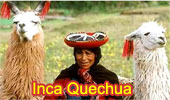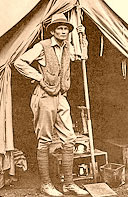Quechua: the Inca Language
Hiram Bingham, the American explorer who found the
ruins of Machu Picchu in 1911, wrote:
Some American archaeologists are prone to
shorten the length of time during which the civilization of the Incas
was developing. Because the Mayas of Central America used hieroglyphics
and invented a calendar it is easy to grant them a couple of thousand
years, while the Incas are limited to a few hundred. Technically they
are right, if one chooses to restrict the use of the word Inca to the
few centuries when the rulers were actually called Incas. But if one
uses the term Inca to characterize that remarkable civilization
discovered by the Spaniards in the sixteenth century, with its advanced
agriculture, its magnificent engineering works and its success over
centuries in producing from an exceedingly wild ancestor two such
distinct domestic and pure-bred animals as the llama and alpaca, it
becomes evident that the period covered by the growth of this ancient
Peruvian civilization certainly must have lasted for several thousand
years.
This theory is also confirmed by the many
varieties of both potatoes and corn found in Inca land, and also by the
fact that the guinea pigs (cuyes) which they domesticated and bred are
as widely different in color and in coat as are the cats of the
Mediterranean region which are known to be of extremely ancient lineage.
Unfortunately
the ancient Peruvians never developed any
form of script or picture writing. It is
indeed a great pity that the Incas never had
the opportunity, as did the Greeks and
Romans, to come in contact with a people
like the Phoenicians who were clever enough
to invent an alphabet.
The language of
the Incas was the Quichua or
Quechua tongue. Originally it was used
only in a small area around Cuzco where the
Inca dynasty originated, possibly in the
tenth or eleventh century. During the next
five hundred years, when the Incas succeeded
in subduing the native races as far north as
Ecuador and as far south as Argentina, they
carried the Quechua language with them and
insisted in its being learned by the
conquered peoples so that it had a wide
distribution by the end of the sixteenth
century.

Today (1911) the
total population of Peru is about seven
million. A recent census reports that two
and one-half million speak Quechua and
two-thirds of these speak no other
languages. Although there are many different
languages spoken by small forest tribes in
the Amazon basin, there are only two
aboriginal languages numerically important
in the Andes, Quechua and Aymara. In the
region around Lake Titicaca and in northern
Bolivia the Indians speak Aymara which has a
phonetic system and grammar similar to
Quechua. Neither of these languages is
related in any way to those of eastern South
America nor to any outside the continent.
Philological experts are of the opinion that
nearly five million people in South America
still speak the language of the Incas.
Obviously it is by far the most important
native language in either North or South
America. That this phonetic system is so
widespread is in itself a remarkable tribute
to the extraordinary people who were so
successful in breeding animals and plans.
There are few
words in Quechua to denote abstract
qualities. On the other hand, the people
obviously were not militaristic for the word
meaning "soldier" also means "enemy." The
extent of the empire is emphasized by the
fact that the word for "foreigner" means
"those belonging to a city a great distance
off." The importance of agriculture is
strikingly demonstrated by the fact that in
Quechua there is but one word for "work" or
"cultivate." Apparently cultivating the soil
was the only thing which rated as work.
An interesting
commentary on the habits of the ancient
people and a sidelight on their manners and
customs is the abundance of expressions in
Quechua for all stages of drunkenness. One
of their principal activities was the
manufacture of beer or chicha. It was
brewed from sprouted corn which served the
Andean people as an upper mill-stone or
pestle. The Indians of Mexico and Central
America in grinding their corn use a miller,
pushed back and forth on a slab. This is
more fatiguing and requires more effort than
the rocking stone invented in the Andes. The
fact that the most common necessity of the
household, a means of grinding corn, was not
the same with the Incas as with the Mayas,
points to the long period of separate
evolution.
The Incas domesticated at least three
varieties of dogs but there is no evidence that, like the Polynesians,
they used any of them as an article of food.
Source:
Lost City of the Incas, The Story of Machu
Picchu and its Builders by Hiram Bingham
The American explorer who found the ruins of Machu Picchu in 1911.

Hiram Bingham at Machu Picchu
The inspiration for Indiana Jones?
Glossary of Quechua Words:
|
Quechua |
Translation |
|
Acllacuna |
Chosen Women |
|
Alpaca |
Domestic camel animal |
|
Apachita |
Sacred offering, cairn |
|
Aquilla |
Golden goblet |
|
Ayllu |
Social division, 'clan' |
|
Canca |
Sacred bread |
|
Charqui |
Dried, 'jerked' meat |
|
Chasqui |
Relay runner |
|
Chicha |
Fermented beverage, corn
beer |
|
Chullpa |
Burial vault or tower |
|
Chuņu |
Desiccated potatoes |
|
Coca |
Narcotic plant |
|
Collahuaya |
Class of native
physicians |
|
Coya |
Queen |
|
Curaca |
Queen |
|
Guaman |
Province, political
division |
|
Guanaco |
Wild camel animal |
|
Guano |
Bird or bat excrement |
|
Hauasipascuna |
'Left-out Girls' |
|
Hihuaya |
A form of punishment |
|
Huaca |
Sacred place,
archaeological site |
|
Huaco |
Archaeological site |
|
Huaquero |
Native digger, treasure
hunter |
|
Huahuqui |
Supernatural Guardian,
brother |
|
Huayara |
Fertility festival |
|
Ichu |
Coarse grass |
|
Inca |
Inca |
|
Llama |
Domesticated camel
animal |
|
Llama |
Fillet, head-band |
|
Macanamaqna |
War club |
|
Mamacuna |
Mother Superior |
|
Mita |
Tax-service |
|
Mitima(es) |
Compulsory colonist,
settler |
|
Napa |
White (albino) llama |
|
Oca |
Cultivated tuber
(oxalis) |
|
Pachaca |
Political unit of 100
families |
|
Pampa |
Low-level treeless or
grassy plain |
|
Pirca |
Masonry of undressed
field stones |
|
Pucara |
Fortress |
|
Puna |
High-level grassy plan |
|
Puric |
Able adult man, head of
household |
|
Quechua |
Quechua |
|
Quero |
Wooden goblet |
|
Quinua |
Cultivated amaranth (Chenopodium) |
|
Quipu |
Knotted record |
|
Quipucamayoc |
Knot-record keeper |
|
Saya |
Section of a province |
|
Sinchi |
Chief, leader |
|
Situa |
Curative festival |
|
Suyu |
Quarter of empire |
|
Taclla |
Spade or foot-plough |
|
Tambo |
Inn, barracks |
|
Tocco |
Cave mouth, window |
|
Topo |
Shawl pin; standard of
measurement |
|
Totora |
Reed, rushes |
|
Vicuņa |
Fine-haired wild camel
animal |
|
Villac Umu |
High Priest |
|
Villca |
A narcotic (Piptadenia) |
|
Yacarca |
Soothsayer, diviner |
|
Yancuna |
Class of servants |
Reference: ' The Ancient Civilizations of
Peru' by J. Alden Mason, 1957
|
Online Book Shopping
|
 
|
|
She-Calf and Other Quechua Folk Tales (English and Spanish Edition)
by Johnny Payne
Textbook (Paperback - 1 ED)
These fables from highland Peru, presented in both Quechua and English,
capture a rich oral tradition and illustrate many universal human
themes. This bilingual edition, the first collection of stories from the Cusco region to be published in English, captures a rich but fast disappearing oral tradition. The ethnographic introduction, a poignant re-creation of what living and working with Quechua speakers reveals to a perceptive and appreciative outsider, is conversational, witty, and memorable for its insights.
Biography
Johnny Payne, a novelist, playwright, and translator, is a specialist in
comparative literature. He directs the creative writing program at
Florida Atlantic University. For three years he headed a summer
institute in Quechua history and literature in Cusco, Peru. |
|